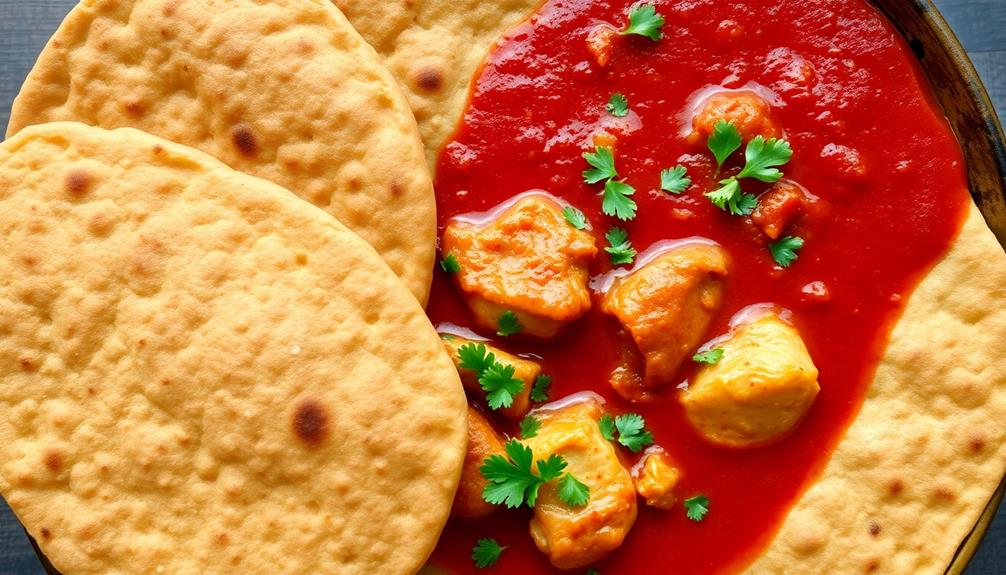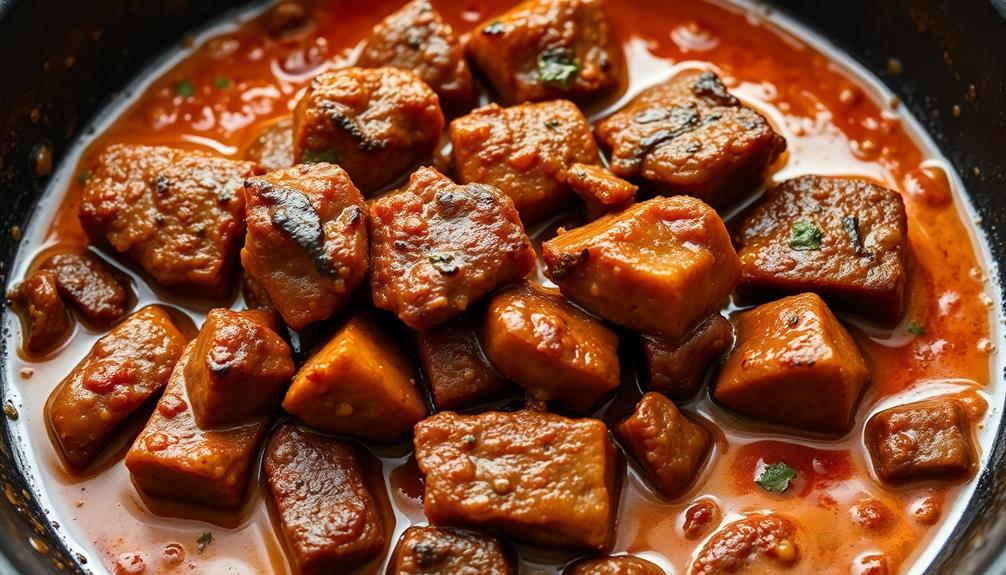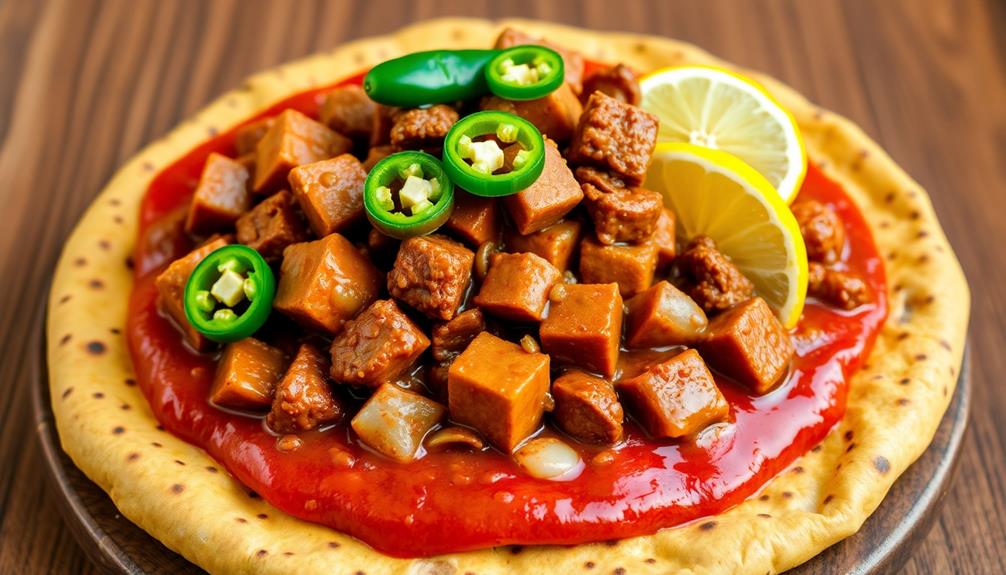Injera and doro wat are the foundations of traditional Ethiopian cuisine, tracing their origins back centuries. You'll find the spongy, fermented injera flatbread paired with the aromatic, spicy chicken stew of doro wat at gatherings and celebrations, symbolizing the country's cultural identity. Preparing these dishes requires precise techniques, from the injera's 2-3 day fermentation process to the long, slow simmering of the doro wat. As you dive into this quintessential Ethiopian feast, you'll uncover the rich history, complex flavors, and communal spirit that make it an unforgettable culinary experience.
Key Takeaways
- Injera and Doro Wat are ancient staple dishes in Ethiopian cuisine, tracing their origins to the 4th century AD and reflecting the country's cultural heritage.
- The communal dining experience of sharing Doro Wat stew with injera flatbread promotes social bonding and represents traditional Ethiopian hospitality.
- Injera's unique preparation involves a multi-day fermentation process, while Doro Wat combines marinated chicken, aromatic spices, and a rich tomato-based sauce.
- The dishes feature a complex, balanced flavor profile with earthy spices, tender chicken, and the soft, spongy texture of injera creating a satisfying dining experience.
- The growing global popularity of Ethiopian cuisine encourages culinary exploration and a deeper appreciation for the country's rich culinary traditions.
History
Tracing the origins of Injera with Doro Wat, you'll find that this iconic Ethiopian dish has roots dating back centuries. The spongy flatbread, Injera, has been a staple in the Ethiopian diet since the 4th century AD, while the spicy chicken stew, Doro Wat, has been a beloved accompaniment for just as long.
Together, they form the foundation of traditional Ethiopian cuisine, a culinary legacy that's been passed down through generations.
The recipes have evolved over time, but the core ingredients and preparation methods have remained largely unchanged. Injera is still made from the ancient grain, teff, and Doro Wat still features the complex blend of spices that give it its distinctive flavor.
These dishes aren't just meals – they're a reflection of Ethiopian culture, history, and identity. Every bite tells a story of a resilient people and their enduring culinary traditions.
Recipe
Injera is a spongy, fermented flatbread that serves as the foundation for many Ethiopian dishes, including the beloved Doro Wat. This fragrant chicken stew, with its complex blend of spices, is the perfect accompaniment to the tangy and slightly sour injera.
To create an authentic Ethiopian dining experience, it's important to prepare both the injera and the Doro Wat with care. The injera requires a bit of forethought, as the batter needs to ferment for several days before cooking. The Doro Wat, on the other hand, is a dish that rewards patience, with the flavors deepening the longer it simmers.
Ingredients:
- 2 cups teff flour
- 1 cup warm water
- 1 teaspoon active dry yeast
- 1/4 teaspoon salt
- 1 lb boneless, skinless chicken thighs, cut into bite-sized pieces
- 1 onion, diced
- 3 cloves garlic, minced
- 2 tablespoons berbere spice mix
- 1 cup chicken stock
- 1 (6 oz) can tomato paste
- 2 hard-boiled eggs, peeled and quartered
- 2 tablespoons niter kibbeh (Ethiopian spiced butter)
To prepare the injera, combine the teff flour, warm water, yeast, and salt in a large bowl. Cover and let the batter ferment for 2-3 days at room temperature.
When ready to cook, heat a large non-stick skillet over medium heat and pour about 1/4 cup of the batter, swirling to create a thin, round flatbread. Cook for 2-3 minutes, or until the edges start to lift, then flip and cook for another minute.
For the Doro Wat, sauté the onion and garlic in the niter kibbeh until softened. Add the chicken, berbere spice, and chicken stock, and bring to a simmer.
Reduce heat and let the stew simmer for 45-60 minutes, until the chicken is cooked through and the flavors have melded. Stir in the tomato paste and season with salt to taste. Serve the Doro Wat over the injera, garnished with the hard-boiled egg quarters.
When preparing this dish, be mindful of the fermentation time for the injera, and allow the Doro Wat to simmer slowly to develop its rich, complex flavors. Enjoy this authentic taste of Ethiopia!
Cooking Steps
First, gather the injera and the necessary spices.
Next, marinate the chicken for a few hours to let the flavors develop.
Then, sauté the onions in spiced butter, add the berbere spice, and simmer the chicken in the flavorful sauce.
Step 1. Gather Injera and Spices

To prepare the perfect Injera and Doro Wat, you'll need to gather a few key ingredients. First, you'll want to ensure you have fresh Injera, the spongy Ethiopian flatbread that serves as the base for this dish. You can either make it from scratch or purchase it from a local Ethiopian market.
Next, gather the spices for the Doro Wat, the signature Ethiopian chicken stew. You'll need berbere, a vibrant spice blend that's the heart of many Ethiopian dishes. Turmeric, ginger, garlic, and cardamom are also essential. Don't forget onions, tomatoes, and chicken thighs or drumsticks. For a traditional accompaniment, consider making an Ethiopian salad recipe with fresh, crisp vegetables and a zesty dressing. To complete your meal, be sure to have plenty of injera on hand, the spongy flatbread that is a staple in Ethiopian cuisine. With all the flavors and textures at play, your Doro Wat dinner will be a memorable and delicious experience.
Once you have all your ingredients, it's time to start cooking. Prepare the Injera according to the instructions, then move on to the Doro Wat, simmering the chicken in the aromatic spices until the meat is tender and the flavors have melded.
Serve the Doro Wat on top of the Injera, and get ready to embark on a delicious Ethiopian culinary adventure.
Step 2. Marinate Chicken for Flavor Development
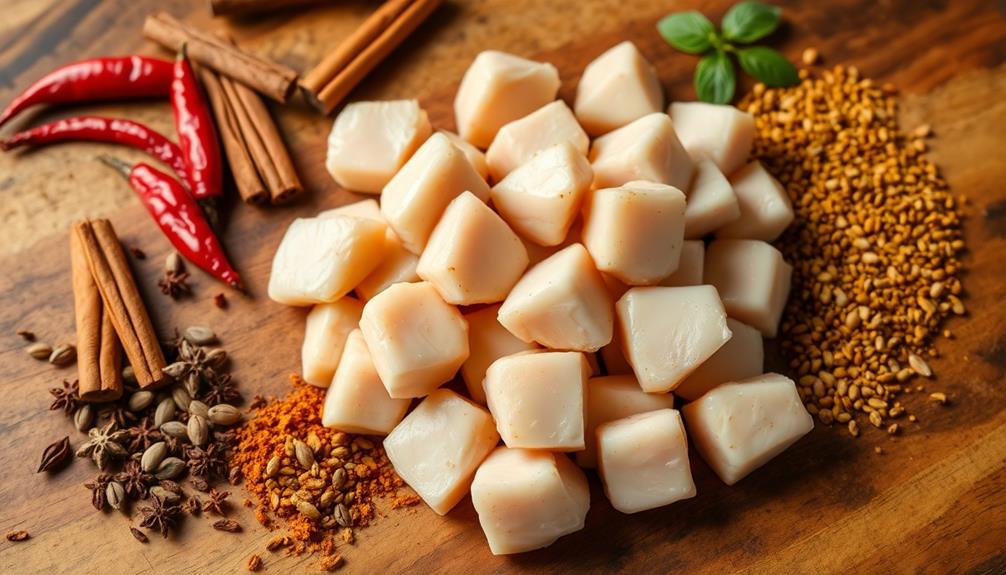
With the Injera and spices ready, let's turn our attention to marinating the chicken. The key to developing rich, complex flavors in the Doro Wat is a well-executed marinade.
Start by combining the garlic, ginger, onion, and berbere spice blend in a large bowl. Generously season the chicken thighs and drumsticks with the fragrant mixture, making sure to coat every nook and cranny.
Cover the bowl and let the chicken marinate for at least 2 hours, or up to 24 hours in the refrigerator. The longer the chicken marinates, the more time the flavors have to penetrate and meld.
When you're ready to cook, remove the chicken from the fridge and let it come to room temperature. This will ensure even cooking.
Now you're one step closer to an authentic Ethiopian feast of Injera and Doro Wat. The aromas wafting from the kitchen will have your guests' mouths watering in anticipation.
Step 3. Sauté Onions in Spiced Butter

Next, heat a large skillet or Dutch oven over medium heat and add the spiced butter.
Once it's melted, toss in the diced onions. Sauté the onions, stirring occasionally, until they're translucent and softened, about 5-7 minutes.
Don't let them brown too much – you want them to retain their sweetness.
As the onions cook, they'll release their natural juices, which will combine with the fragrant spiced butter, creating a delightful aromatic base for the stew.
Keep an eye on the heat and adjust it if needed to prevent the onions from burning.
Once the onions have reached the perfect texture, add the garlic and cook for another minute or two until it becomes fragrant.
Be careful not to let the garlic burn, as that can impart a bitter flavor.
Now your aromatic onion and garlic mixture is ready to serve as the foundation for the flavorful Doro Wat stew.
The next step is to add the spices and continue building the complex flavors of this authentic Ethiopian dish.
Step 4. Add Berbere Spice
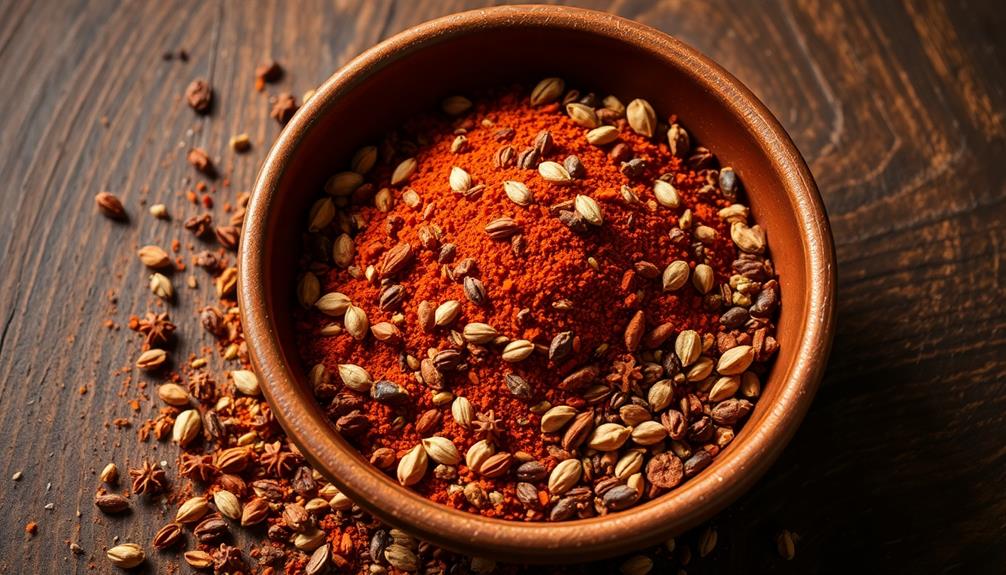
After sautéing the onions and garlic, it's time to add the berbere spice blend. This fragrant mix of chili peppers, ginger, cardamom, cloves, and other aromatic spices will infuse your doro wat with bold, complex flavors.
Sprinkle the berbere over the onion mixture and stir to coat everything evenly. The spices will start to toast and release their oils, filling your kitchen with an intoxicating aroma. Let the berbere cook for a minute or two, stirring constantly, to allow the flavors to meld.
Be careful not to let it burn, as that can create a bitter taste. Once the mixture is fragrant and the spices have bloomed, you can add the chicken and continue cooking the doro wat.
The berbere will lend a distinctive Ethiopian flair, with its earthy, slightly smoky notes and gentle heat. Don't be shy with the spice – this is a dish meant to be bold and flavorful.
Step 5. Simmer Chicken in Spiced Sauce
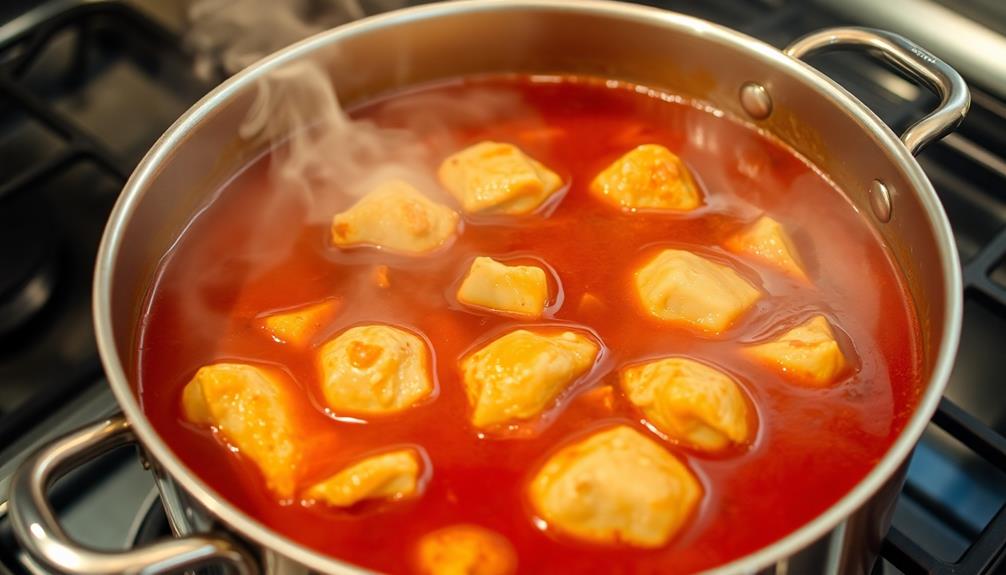
Now that you've added the aromatic berbere spice, it's time to introduce the chicken to the simmering sauce. Gently place the chicken pieces into the pot, ensuring they're fully submerged in the rich, fragrant mixture.
Let the chicken simmer, stirring occasionally, for about 30 minutes. This allows the meat to become deliciously tender and infused with the complex flavors of the sauce.
As the chicken simmers, the sauce will thicken, creating a velvety texture that coats the meat beautifully. Be sure to taste the sauce periodically, adjusting the seasoning as needed. You may want to add a splash of lemon juice or a pinch of sugar to balance the flavors.
The goal is to achieve a harmonious blend of spices that complements the chicken perfectly.
Once the chicken is cooked through, remove it from the heat. The dish is now ready to be served alongside the fluffy injera, allowing the flavors to meld together in every bite.
Final Thoughts
Ultimately, the combination of injera and doro wat is a true delight for the senses. The spongy, slightly sour injera provides the perfect canvas for the rich, aromatic doro wat. Each bite is a symphony of flavors – the earthy spices, the tender chicken, the silky sauce, all coming together in perfect harmony.
What makes this dish so special is the way it encourages interaction and shared experience. Tearing off a piece of injera and using it to scoop up the stew creates a tactile, communal dining experience that brings people together.
The act of sharing a meal in this intimate way fosters connection and a deeper appreciation for the food.
As you savor the final bites, you're left with a sense of satisfaction and a longing to experience this Ethiopian feast again. The flavors linger, beckoning you to return and delve deeper into the complex and captivating world of Ethiopian cuisine.
Frequently Asked Questions
What Is the Typical Serving Size of Injera With Doro Wat?
The typical serving size of injera with doro wat can vary, but a common portion is a large piece of injera accompanied by a generous portion of the savory doro wat stew. The exact amount may depend on individual appetite and preferences.
How Long Can Leftover Injera and Doro Wat Be Stored?
Leftover injera and doro wat can typically be stored in the refrigerator for 3-4 days. Be sure to store them in airtight containers to maintain freshness. When ready to enjoy, simply reheat the dishes before serving.
Are There Any Vegetarian Alternatives to the Doro Wat Recipe?
There are several vegetarian alternatives you can try instead of the traditional doro wat recipe. Consider a lentil stew, chickpea curry, or a veggie-packed saucy dish to pair with your injera.
Can I Use a Different Type of Flour to Make the Injera?
Absolutely, you can use different types of flour to make injera. Try teff, sorghum, or a blend of flours to create a unique version of this traditional Ethiopian flatbread. Experiment and find the flavor profile you enjoy most.
Is It Necessary to Have a Special Pan for Cooking Injera?
You don't necessarily need a special pan to cook injera. While a dedicated injera pan can make the process easier, you can use a regular nonstick skillet or griddle as long as it's large enough to accommodate the batter.
